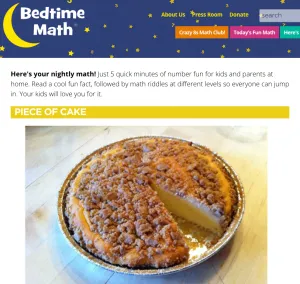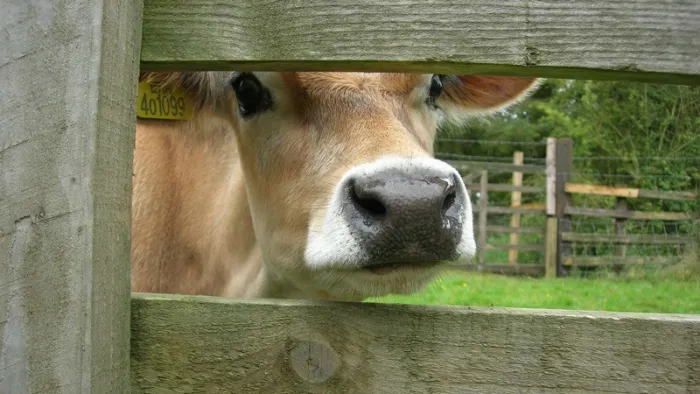How cake, glow sticks, and cow-wrangling can help kids love math.
Fractions make a lot of people sweat. So does algebra. The mere sight of a variable instantly triggers math anxiety. If you write 1/2x + 5 = 9, many grown adults will run screaming from the room.
But say to your favorite 8-year-old, "I'm thinking of a mystery number. I can't tell you what it is, but if you cut it in half and add 5, you get 9," and even before you continue to, "What's the mystery number?" that child will be off and running trying to figure it out -- and will likely solve it. She'll realize that if she had to go up 5 to get to 9, she must have been at 4 before that. And if she had to cut the number in half to get 4, she must have started with 8, the answer. It's the exact same question as that equation, but posed as a mental-math mystery number, suddenly it's no sweat.
How do we tap kids' natural math ability and build momentum from that rather than derailing it?
With all the handwringing over standards and curricula, we've perhaps lost sight of the forest for the trees. Really, if you try a few mystery numbers with young kids, you'll see that they're naturals at algebra. As Southwestern University president Ed Burger said in his National Council of Teachers of Math (NCTM) keynote, "Kids are born loving math and can do even algebra at a young age. It takes a pretty sophisticated curriculum to beat that out of them." The question for the grown-ups here is clear: How do we tap kids' natural math ability and build momentum from that rather than derailing it?

Compare that to the way this subject is traditionally taught. Regardless of which problem-solving tactic or pedagogical approach is used, students are taught that when you add fractions, the "bottoms" must match; when you multiply, they don't. Many students hear this algorithm and simply memorize it, adding it to their ever-growing list of seemingly random rules, such as when they learned to carry the 1. Adding and multiplying are two entirely different exercises. In the first, you have to add apples to apples, and in the second, you're carving one piece out of another, not necessarily whole piece. Unless the teacher explains the mechanics happening under the surface, students are left adrift. They struggle to remember steps and the order in which to take them, instead of gaining true math fluency and comfort with numbers. With the cakes, they're actually wrestling with a real-life problem they might face at mealtime or during a playdate. They care about the outcome, so they dive in to understand it.
The key to all this is letting kids wrangle playfully with problems before giving them any formal instruction on the topic.
These examples involve computation, but the same thinking can apply to spatial skills, a whole other arena at which kids can excel. Three-dimensional solids follow a really cool pattern discovered by Euler: The number of faces (flat sides) plus the number of vertices (pointy corners) minus the number of edges always equals 2. You could write this on the blackboard and hope students remember it. Alternatively, you could hand them a stack of glow sticks and Styrofoam balls, as we do in Bedtime Math's "Crazy 8s" after-school math club, and let the kids build 3-D shapes themselves to see how the edges, faces, and corners relate to each other. Once kids derive it, they'll never have to memorize it.

Some exercises blend both the spatial and the computational, and that integrated kind of learning really sings. In her book What's Math Got to Do with It?, Stanford professor Jo Boaler describes a classroom lesson involving fence pieces: The teacher gives 36 equal lengths to the students and tells them to fence in the biggest possible area for their cows. Right away the kids discover a truth that even grown-ups don't grasp: A line of a certain length can outline rectangles with vastly different areas. A long skinny rectangle -- let's say 17 by 1 -- has almost no area, but the closer to the perfect 6-x-6 square, the bigger the area. Eventually the kids break out of the rectangle mode of thinking and realize they should aim to make a circle, best approximated by a 36-sided polygon. By the end of that lesson, they've learned a key geometry reality and practiced their math facts, too.
Note that all these playful exercises reflect the kind of recreation kids do outside school. And because they're independent of any particular curriculum, they can coexist quite peacefully alongside the ongoing lessons required to prep for the looming standardized test. Ironically, these activities probably prepare kids better not only for those tests but for their adult lives. By stoking their interest and engagement in the subject, we can let kids have their cake and eat it, too.
"nosy cow" by richardoyork used under a CC BY-NC-ND 2.0 license.
"no icons, by request" by Katie Walker used under a CC BY-SA 2.0 license.







